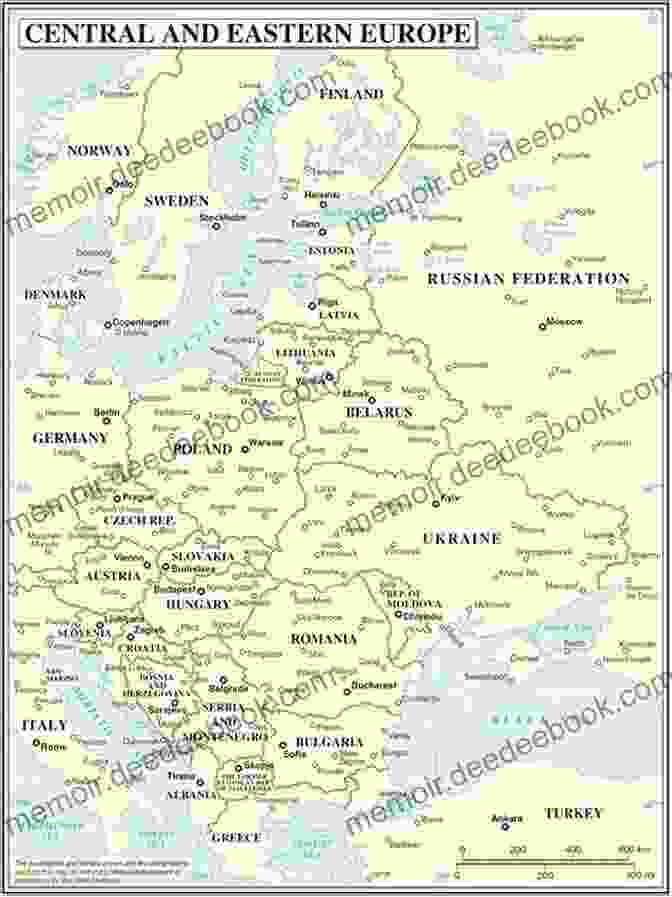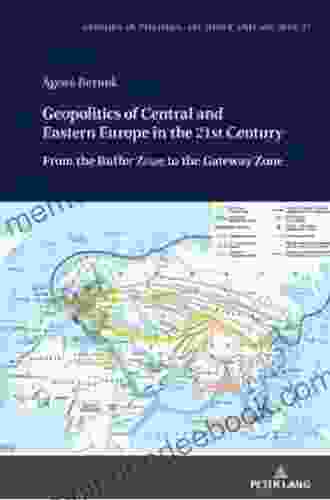Geopolitics of Central and Eastern Europe in the 21st Century: A Comprehensive Overview

Central and Eastern Europe (CEE) has been a geopolitical crossroads and a region of strategic importance throughout history. With the fall of the Soviet Union and the end of the Cold War in the late 20th century, the region experienced significant political, economic, and social transformations. These changes have shaped the contemporary geopolitics of CEE, making it a dynamic and ever-evolving region.
5 out of 5
| Language | : | English |
| File size | : | 4577 KB |
| Text-to-Speech | : | Enabled |
| Screen Reader | : | Supported |
| Enhanced typesetting | : | Enabled |
| Word Wise | : | Enabled |
| Print length | : | 284 pages |
Historical Context

The historical context of CEE is crucial to understanding its current geopolitical landscape. The region has witnessed the rise and fall of empires, the shifting of borders, and numerous wars and conflicts. The legacy of history continues to influence the political and cultural landscape of CEE, shaping the relationships between different countries and their perceptions of one another.
Economic Development
Since the collapse of communism in the late 1980s, the economies of CEE countries have undergone significant transformations. The region has witnessed a transition from centrally planned economies to market-based systems. While some countries have achieved substantial economic growth and prosperity, others have faced challenges and disparities.
The European Union (EU) has played a major role in the economic development of CEE. Many CEE countries have joined the EU and benefited from its economic integration, access to markets, and financial support.
Security Challenges
CEE faces a number of security challenges, including the ongoing conflict in Ukraine, the threat from Russia, and the potential for instability in the Balkans. The conflict in Ukraine, which began in 2014, has had a profound impact on the region and has raised concerns about wider conflict between Russia and the West.
Russia remains a major player in CEE and continues to exert significant influence in the region. Russia's annexation of Crimea and its support for separatists in eastern Ukraine have raised tensions and concerns about the future of European security.
Political Instability
Some CEE countries have experienced political instability and challenges to democracy. The rise of populist and nationalist movements, as well as corruption and organized crime, have posed threats to the stability and democratic institutions of the region.
The EU has been actively involved in promoting democracy and the rule of law in CEE, providing support to democratic institutions and civil society organizations.
Regional Cooperation
Regional cooperation and integration have become increasingly important in CEE. The EU has served as a framework for economic and political cooperation, and many CEE countries have joined the organization. Other regional organizations, such as the Visegrad Group and the Central European Free Trade Agreement (CEFTA),have also played a role in promoting cooperation and integration.
Regional cooperation in CEE has helped to overcome historical divisions and foster economic and political ties between countries. It has also contributed to the region's stability and security.
Key Players
Several key players shape the geopolitics of CEE. These include:
- Russia: Russia remains a major power in CEE and continues to exert significant influence in the region. Russia's annexation of Crimea and its support for separatists in eastern Ukraine have raised concerns about the future of European security.
- Ukraine: Ukraine is a key country in CEE and has been the focus of geopolitical tensions in recent years. The conflict in eastern Ukraine has had a profound impact on the country and the wider region.
- Poland: Poland is the largest and most populous country in CEE. It plays a leading role in regional cooperation and is a strong advocate for NATO and EU integration.
- Hungary: Hungary is a strategically located country in CEE. It has been a member of NATO and the EU since 2004. Hungary has close ties to Russia and has taken a more independent stance on some foreign policy issues.
- Czech Republic: The Czech Republic is a politically stable and economically prosperous country in CEE. It is a member of NATO and the EU and has played a leading role in promoting democracy and human rights in the region.
- Slovakia: Slovakia is a member of NATO and the EU. It has been a strong supporter of Ukraine and has condemned Russia's aggression in eastern Ukraine.
- Slovenia: Slovenia is a member of the EU and NATO. It has achieved significant economic development and prosperity since joining the EU. Slovenia is also an active participant in regional cooperation initiatives.
- Croatia: Croatia is a member of the EU and NATO. It has been a stable and democratic country since joining the EU in 2013.
- Bosnia and Herzegovina: Bosnia and Herzegovina is a country in the Western Balkans that is still recovering from the war of the 1990s. It is a potential candidate for EU and NATO membership.
- Serbia: Serbia is a country in the Western Balkans that is seeking EU membership. It has close ties to Russia and has taken a more neutral stance on the conflict in Ukraine.
- Montenegro: Montenegro is a member of NATO and a candidate for EU membership. It has been a close ally of the West and has supported Ukraine in its conflict with Russia.
- North Macedonia: North Macedonia is a country in the Western Balkans that is a candidate for EU and NATO membership. It has been a strong supporter of Ukraine and has condemned Russia's aggression.
- Albania: Albania is a member of NATO and a candidate for EU membership. It has been a close ally of the West and has supported Ukraine in its conflict with Russia.
- Kosovo: Kosovo is a partially recognized country in the Western Balkans that declared independence from Serbia in 2008. It is a potential candidate for EU and NATO membership.
Challenges and Outlook
The geopolitics of CEE continues to evolve, and the region faces a number of challenges. These include:
- The ongoing conflict in Ukraine: The conflict in eastern Ukraine remains a major challenge for CEE and has the potential to escalate into a wider conflict between Russia and the West.
- The threat from Russia: Russia continues to be a major security threat to CEE, and its aggression in Ukraine has raised concerns about the future of European security.
- Political instability: Some CEE countries face challenges to democracy and political stability. The rise of populist and nationalist movements, as well as corruption and organized crime, pose threats to the stability and democratic institutions of the region.
- Economic disparities: There are significant economic disparities between CEE countries, and some countries continue to face economic challenges and poverty.
Despite these challenges, the geopolitics of CEE is likely to continue to be shaped by the region's historical, economic, and strategic importance. The EU, NATO, and other regional organizations will play a key role in fostering cooperation, promoting stability, and addressing the challenges facing CEE.
CEE is a dynamic and ever-evolving region that has undergone significant transformations in recent decades. The region's geopolitics is shaped by its historical context, economic development, security challenges, political instability, regional cooperation, and key players. CEE faces a number of challenges, but it also has the potential to be a region of peace, stability, and prosperity.
5 out of 5
| Language | : | English |
| File size | : | 4577 KB |
| Text-to-Speech | : | Enabled |
| Screen Reader | : | Supported |
| Enhanced typesetting | : | Enabled |
| Word Wise | : | Enabled |
| Print length | : | 284 pages |
Do you want to contribute by writing guest posts on this blog?
Please contact us and send us a resume of previous articles that you have written.
 Book
Book Page
Page Text
Text Story
Story Genre
Genre Reader
Reader E-book
E-book Newspaper
Newspaper Paragraph
Paragraph Sentence
Sentence Bookmark
Bookmark Shelf
Shelf Glossary
Glossary Foreword
Foreword Preface
Preface Synopsis
Synopsis Annotation
Annotation Footnote
Footnote Manuscript
Manuscript Scroll
Scroll Codex
Codex Library card
Library card Biography
Biography Autobiography
Autobiography Memoir
Memoir Reference
Reference Thesaurus
Thesaurus Character
Character Librarian
Librarian Catalog
Catalog Card Catalog
Card Catalog Research
Research Academic
Academic Rare Books
Rare Books Interlibrary
Interlibrary Thesis
Thesis Dissertation
Dissertation Awards
Awards Reading List
Reading List Theory
Theory Daniel Tubb
Daniel Tubb Marcy Pusey
Marcy Pusey Kim Cano
Kim Cano Judith Merkle Riley
Judith Merkle Riley Alice Brereton
Alice Brereton Lisa O Neill
Lisa O Neill Douglas Holt
Douglas Holt Steven J Rolfes
Steven J Rolfes J S Wood
J S Wood Claire Bond Potter
Claire Bond Potter Jill Eileen Smith
Jill Eileen Smith Alfred Williams
Alfred Williams Colin James
Colin James Daytona Watterson
Daytona Watterson Roberto Piumini
Roberto Piumini Joseph P Ficalora
Joseph P Ficalora Alfred Bekker
Alfred Bekker Guy Blaze
Guy Blaze Seigaku Amato
Seigaku Amato Katie B Smith
Katie B Smith
Light bulbAdvertise smarter! Our strategic ad space ensures maximum exposure. Reserve your spot today!

 DeShawn PowellThe Elusive Enigma: Unveiling the Tale of the Hip-Hop Duo That Doesn't Exist
DeShawn PowellThe Elusive Enigma: Unveiling the Tale of the Hip-Hop Duo That Doesn't Exist Eliot FosterFollow ·13k
Eliot FosterFollow ·13k Gil TurnerFollow ·12.2k
Gil TurnerFollow ·12.2k Henry David ThoreauFollow ·15.3k
Henry David ThoreauFollow ·15.3k Andrew BellFollow ·3.5k
Andrew BellFollow ·3.5k Anton ChekhovFollow ·16.3k
Anton ChekhovFollow ·16.3k Clinton ReedFollow ·18.4k
Clinton ReedFollow ·18.4k Patrick RothfussFollow ·6k
Patrick RothfussFollow ·6k Garrett PowellFollow ·19.4k
Garrett PowellFollow ·19.4k

 Vernon Blair
Vernon BlairHow to Get a Woman to Pay for You: A Comprehensive Guide...
In the modern dating...

 Levi Powell
Levi PowellPrinciples and Theory for Data Mining and Machine...
Data mining and machine learning are two...

 Andrew Bell
Andrew BellMirrors For The Mind: Milestones In Discovery And...
Mirrors have been a part of human history...

 Alec Hayes
Alec HayesDelving into Natural Language Processing with Java and...
Natural Language Processing (NLP) is an...
5 out of 5
| Language | : | English |
| File size | : | 4577 KB |
| Text-to-Speech | : | Enabled |
| Screen Reader | : | Supported |
| Enhanced typesetting | : | Enabled |
| Word Wise | : | Enabled |
| Print length | : | 284 pages |














